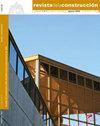混凝土覆盖层厚度和混凝土强度对高温暴露FRP钢筋混凝土温度传递的影响
IF 1.4
4区 工程技术
引用次数: 1
摘要
虽然纤维增强塑料重量轻,抗拉强度高,没有腐蚀问题,但不幸的是,它们很脆,抗温度性能很差。因此,在钢筋混凝土结构构件中以钢筋形式产生frp的高温效应中,了解温度到达钢筋的时间和大小是很重要的。本研究旨在研究玻璃纤维增强聚合物(GFRP)增强混凝土在高温下的时间和温度值。试验研究了混凝土覆盖层厚度和混凝土强度对温度传递的影响。将GFRP筋置于三种混凝土强度、三种不同混凝土覆盖厚度(20 ~ 40 ~ 60 mm)的受温试样中,通过测量钢筋温度、混凝土表面温度和环境温度,绘制温度-时间曲线。讨论了玻璃钢玻璃化转变温度的临界时间,以及玻璃钢根据混凝土强度和混凝土覆盖厚度的最佳覆盖厚度。研究结果似乎表明,混凝土覆盖层的厚度在保护钢筋混凝土结构构件中的钢筋不受温度影响方面非常有效,因为混凝土强度本身的影响有限。本文章由计算机程序翻译,如有差异,请以英文原文为准。
Effects of concrete cover thickness and concrete strength on temperature transfer in high temperature exposed FRP reinforced concrete
While Fibre-Reinforced Plastics are lightweight, show a high tensile strength, and have no issue with corrosion, they are unfortunately brittle and perform poorly against temperature. Therefore, it is important to know the time and magnitude of the temperature reaching the bars in the high-temperature effect of FRPs produced in the form of bar in reinforced concrete structural elements in concrete. This study set out to examine the time and temperature values of glass fiber reinforced polymer (GFRP) reinforced concrete under high-temperatures. The effects of concrete cover thickness and concrete strength on temperature transfer were researched experimentally. GFRP bars were placed in specimens prepared in three concrete strengths and three different concrete cover thicknesses (20-40-60 mm) exposed to temperature, and temperature-time graphs were created by measuring bar temperature, concrete surface temperature and ambient temperature. The critical time to a glass transition temperature, and optimum cover thickness of GFRPs according to concrete strength and concrete cover thickness were discussed. The study results appeared to indicate that the thickness of the concrete cover is very effective in protecting the bar against temperature in reinforced concrete structural elements, as concrete strength, itself, has only a limited effect.
求助全文
通过发布文献求助,成功后即可免费获取论文全文。
去求助
来源期刊

Revista de la Construccion
工程技术-工程:土木
CiteScore
2.30
自引率
21.40%
发文量
0
期刊介绍:
The Journal of Construction is aimed at professionals, constructors, academics, researchers, companies, architects, engineers, and anyone who wishes to expand and update their knowledge about construction. We therefore invite all researchers, academics, and professionals to send their contributions for assessment and possible publication in this journal. The publications are free of publication charges.
OBJECTIVES
The objectives of the Journal of Construction are:
1. To disseminate new knowledge in all areas related to construction (Building, Civil Works, Materials, Business, Education, etc.).
2. To provide professionals in the area with material for discussion to refresh and update their knowledge.
3. To disseminate new applied technologies in construction nationally and internationally.
4. To provide national and foreign academics with an internationally endorsed medium in which to share their knowledge and debate the topics raised.
 求助内容:
求助内容: 应助结果提醒方式:
应助结果提醒方式:


